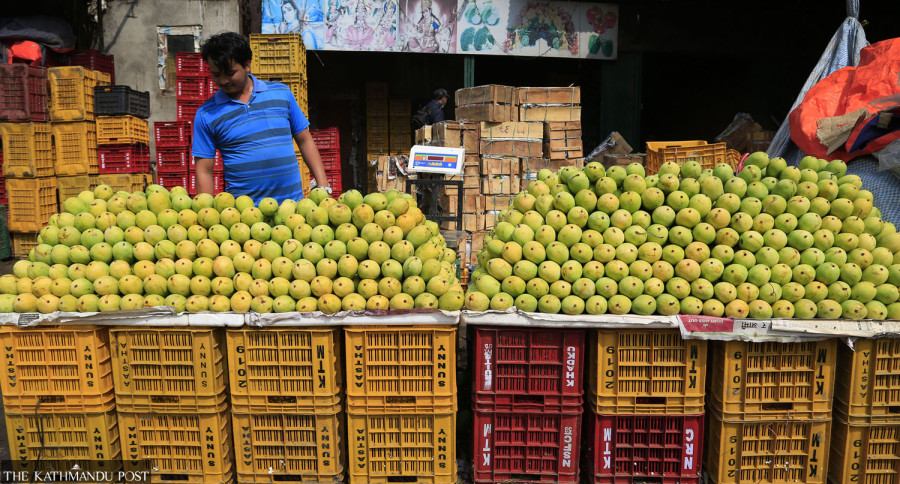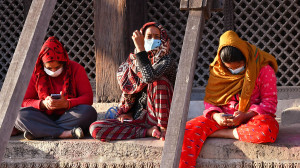Money
Nepal market prices mock central bank’s inflation claims
Despite official inflation at a four-year low, for most families, everyday costs remain high.
Krishana Prasain
Kalpana Phuyal stands in the narrow alley outside her rented flat in Syuchatar, Kathmandu, balancing a bag of vegetables in one hand and her mobile phone in the other.
“A kilo of tomatoes cost me Rs70 even when the price is supposedly low,” she says, her voice heavy with frustration. The 35-year-old works as an office helper in a nearby school, and with a family of five to care for, every rupee feels stretched to its limit.
“It has become difficult to arrange essential household needs,” she says. “Edible oil, rent, children’s school fees, everything’s gone up. But our incomes haven’t.”
Phuyal’s story is echoed across Nepal, particularly among working-class families.
Her husband drives for a private company, but their combined earnings rarely suffice. “Some months we borrow from friends or relatives just to make ends meet,” she admits. Prices of basic foods like mutton have surged—from Rs1,000 to Rs1,400 per kilo. A single egg now costs nearly Rs25, up from Rs15 a couple of years ago.
But, on paper, things are improving.
According to the Nepal Rastra Bank, consumer price inflation in Nepal dropped to 2.77 percent in mid-May 2025, the lowest in over four years. Food and beverage inflation is reported at just 1.52 percent, while non-food and service inflation is 3.45 percent.
But statistics and lived experiences don’t always align.
Prem Thapa, a schoolteacher from Kalanki, says he has stopped buying fruits regularly. “A kilo of apples is nearly Rs400. You get three small apples for Rs200. At that price, I can feed my family vegetables instead,” he says. “My salary hasn’t increased, but everything else has.”
Official data does show steep rises in the prices of specific items.
Under the food and beverage category, ghee and oil prices have increased by 11.08 percent, fruit by 6.15 percent, and pulses by 5.17 percent. Prices for milk products and eggs are up 2.78 percent, and cereal grains are 2.38 percent higher. On the non-food side, education costs have risen by 5.88 percent, while miscellaneous goods and services have jumped 9.04 percent.
Why, then, does the broader inflation rate look relatively calm?
Nara Bahadur Thapa, former executive director of Nepal Rastra Bank, offers a technical explanation: “Inflation has declined mainly due to a collapse in aggregate demand. Consumption expenditure is falling, especially as more youths migrate abroad for study and work. Private sector investment is down, and the government’s capital spending has shrunk.”
With less money circulating in the domestic economy, there’s less demand, which slows price growth. Fuel prices have also dropped globally, except for recent upticks tied to geopolitical tensions between Israel and Iran.
Yet, Thapa warns against confusing low inflation with affordability. “There is a difference between inflation and price level,” he says. “Inflation is the rate at which prices rise. But if the price level is already too high, even low inflation doesn’t help consumers feel a sense of relief.”
Nepal’s rent, food, and transport remain expensive relative to average incomes, especially for low- and fixed-income families. “The structural price level needs to be addressed,” he insists. “Otherwise, households will remain under pressure.”
Another issue is how Nepal measures inflation. The consumer price index, the metric used by Nepal Rastra Bank to track inflation, may not reflect the experiences of the most vulnerable. Although the index has grown to include over 500 goods and services, critics argue that it still fails to capture the realities of low-income households.
“In other countries, inflation is broken down into food, energy, and non-food. Here, we look at an overall basket. But what if the prices of items important to poor families are going up, and those used by wealthier groups are going down?” Thapa questions. “Then the average doesn’t reflect reality.”
He says a separate, representative index for low-income groups would better capture their challenges. Without it, families like Kalpana’s remain invisible in the data—even as they visibly struggle.
Even regional data shows discrepancies.
In May, consumer price inflation was highest in Koshi Province at 4.29 percent, followed by Sudurpaschim (3.14 percent), Madhesh (2.81 percent), Bagmati (2.40 percent), Gandaki (2.23 percent), and Lumbini (2.15 percent). Karnali had the lowest inflation at 2.21 percent. While these figures vary, they do little to explain the squeeze families feel at grocery stores and vegetable markets.
Nepal’s economy relies heavily on imports—mainly from India—and there are broader risks, too. India’s inflation stood at 3.16 percent in April, and any further rise in crude oil or food prices in India will quickly impact Nepal.
The current downward inflation trend could reverse if global instability worsens, as seen in the Israel-Iran conflict.
But for now, the bigger concern is structural. Relief will remain elusive until the cost of living matches incomes and inflation figures genuinely reflect all economic groups.
Phuyal glances down at her shopping bag again—half-filled, with just enough vegetables for one meal. “Every day, I have to make choices. Do we buy eggs? Do we skip fruits? Can we pay the school fees this month?” she says. “They say prices are stable. But is this ‘stable’ affordable?”




 10.12°C Kathmandu
10.12°C Kathmandu













%20(1).jpg&w=300&height=200)
